”Houston, We’ve Had a Problem"
By JAMES A. LOVELL
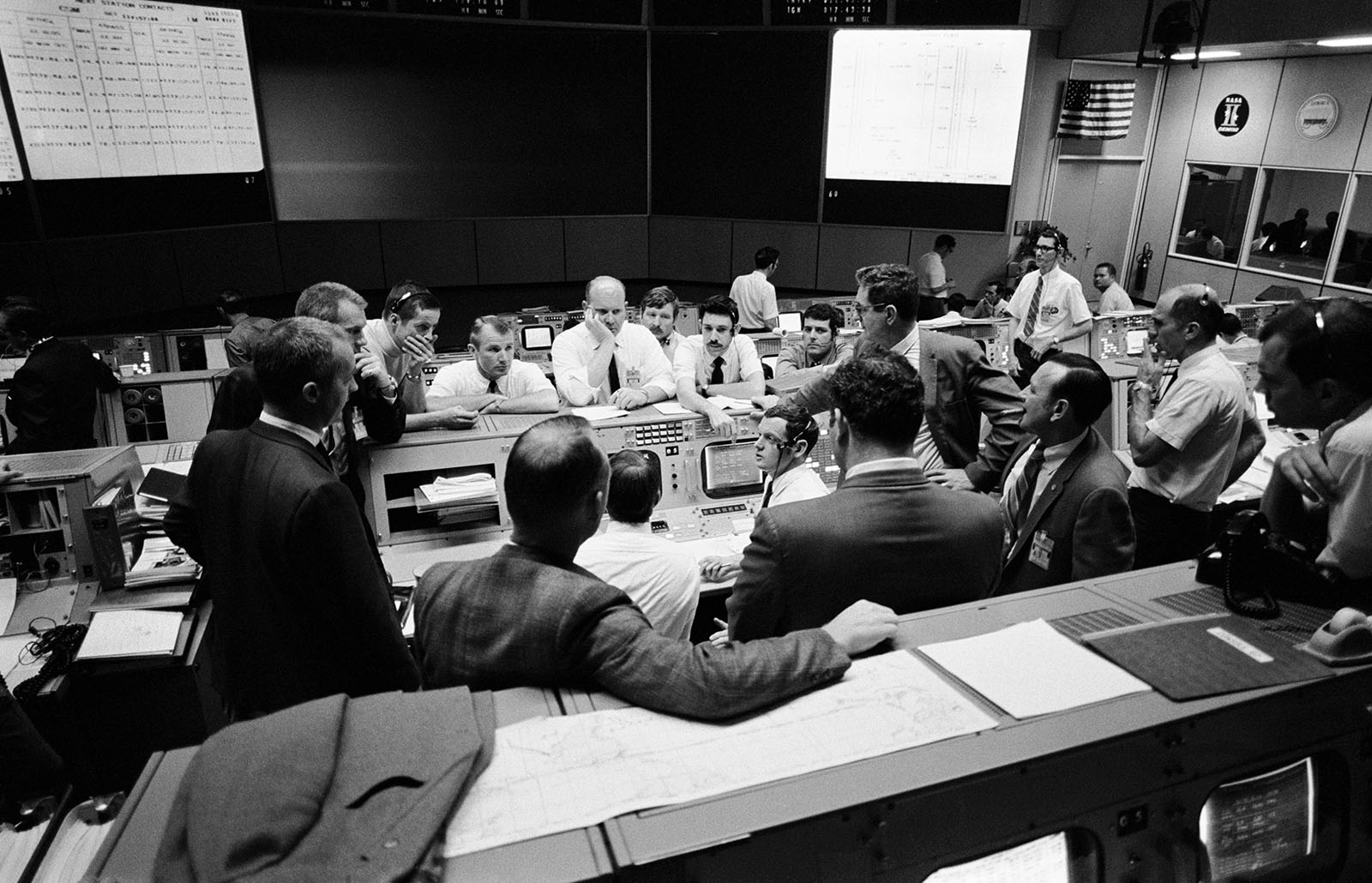
Since Apollo 13 many people have asked me, “Did you have suicide pills on board?” We didn’t, and I never heard of such a thing in the eleven years I spent as an astronaut and NASA executive.
I did, of course, occasionally think of the possibility that the spacecraft explosion might maroon us in an enormous orbit about the Earth - a sort of perpetual monument to the space program. But Jack Swigert, Fred Haise, and I never talked about that fate during our perilous flight. I guess we were too busy struggling for survival.
Survive we did, but it was close. Our mission was a failure but I like to think it was a successful failure.
Apollo 13, scheduled to be the third lunar landing, was launched at 1313 Houston time on Saturday, April 11, 1970; I had never felt more confident. On my three previous missions, I had already logged 572 hours in space, beginning with Gemini 7, when Frank Borman and I stayed up 14 days- a record not equaled until Skylab.
Looking back, I realize I should have been alerted by several omens that occurred in the final stages of the Apollo 13 preparation. First, our command module pilot, Ken Mattingly, with whom Haise and I had trained for nearly two years, turned out to have no immunity to German measles (a minor disease the backup LM pilot, Charlie Duke, had inadvertently exposed us to). I argued to keep Ken, who was one of the most conscientious, hardest working of all the astronauts. In my argument to Dr. Paine, the NASA Administrator, I said, “Measles aren’t that bad, and if Ken came down with them, it would be on the way home, which is a quiet part of the mission. From my experience as command module pilot on Apollo 8, I know Fred and I could bring the spacecraft home alone if we had to.” Besides, I said, Ken doesn’t have the measles now, and he may never get them. (Five years later, he still hadn’t.)
Dr. Paine said no, the risk was too great. So I said in that case we’ll be happy to accept Jack Swigert, the backup CMP, a good man (as indeed he proved to be, though he had only two days of prime-crew training).
The second omen came in ground tests before launch, which indicated the possibility of a poorly insulated supercritical helium tank in the LM’s descent stage. So we modified the flight plan to enter the LM three hours early, in order to obtain an onboard readout of helium tank pressure. This proved to be lucky for us because it gave us a chance to shake down this odd-shaped spacecraft that was to hold our destiny in its spidery hands. It also meant the LM controllers were in Mission Control when they would be needed most.
Then there was the No. 2 oxygen tank, serial number 10024X-TA0009. This tank had been installed in the service module of Apollo 10, but was removed for modification (and was damaged in the process of removal). I have to congratulate Tom Stafford, John Young, and Gene Cernan, the lucky dogs, for getting rid of it.
This tank was fixed, tested at the factory, installed in our service module. and tested again during the Countdown Demonstration Test at the Kennedy Space Center beginning March 16, 1970. The tanks normally are emptied to about half full, and No. 1 behaved all right. But No. 2 dropped to only 92 percent of capacity. Gaseous oxygen at 80 psi was applied through the vent line to expel the liquid oxygen, but to no avail. An interim discrepancy report was written, and on March 27, two weeks before launch, detanking operations were resumed. No. 1 again emptied normally, but its idiot twin did not. After a conference with contractor and NASA personnel, the test director decided to “boil off” the remaining oxygen in No. 2 by using the electrical heater within the tank. The technique worked, but it took eight hours of 65-volt DC power from the ground-support equipment to dissipate the oxygen.
With the wisdom of hindsight, I should have said, “Hold it. Wait a second. I’m riding on this spacecraft. Just go out and replace that tank.” But the truth is, I went along, and I must share the responsibility with many, many others for the $375 million failure of Apollo 13. On just about every spaceflight we have had some sort of failure, but in this case, it was an accumulation of human errors and technical anomalies that doomed Apollo 13.
At five and a half minutes after liftoff, Swigert, Haise, and I felt a little vibration. Then the center engine of the S-II stage shut down two minutes early. This caused the remaining four engines to burn 34 seconds longer than planned, and the S-IVB third stage had to burn nine seconds longer to put us in orbit. No problem: the S-IVB had plenty of fuel.
The first two days we ran into a couple of minor surprises, but generally Apollo 13 was looking like the smoothest flight of the program. At 46 hours 43 minutes Joe Kerwin, the CapCom on duty, said, “The spacecraft is in real good shape as far as we are concerned. We’re bored to tears down here.” It was the last time anyone would mention boredom for a long time.
At 55 hours 46 minutes, as we finished a 49-minute TV broadcast showing how comfortably we lived and worked in weightlessness, I pronounced the benediction: “This is the crew of Apollo 13 wishing everybody there a nice evening, and we’re just about ready to close out our inspection of Aquarius (the LM) and get back for a pleasant evening in Odyssey (the CM). Good night.”
On the tapes I sound mellow and benign, or some might say fat, dumb, and happy. A pleasant evening, indeed! Nine minutes later the roof fell in; rather, oxygen tank No. 2 blew up, causing No. 1 tank also to fail. We came to the slow conclusion that our normal supply of electricity, light, and water was lost, and we were about 200,000 miles from Earth. We did not even have power to gimbal the engine so we could begin an immediate return to Earth.
The message came in the form of a sharp bang and vibration. Jack Swigert saw a warning light that accompanied the bang, and said, “Houston, we’ve had a problem here.” I came on and told the ground that it was a main B bus undervolt. The time was 2108 hours on April 13.
Next, the warning lights told us we had lost two of our three fuel cells, which were our prime source of electricity. Our first thoughts were ones of disappointment, since mission rules forbade a lunar landing with only one fuel cell.
With warning lights blinking on, I checked our situation; the quantity and pressure gages for the two oxygen tanks gave me cause for concern. One tank appeared to be completely empty, and there were indications that the oxygen in the second tank was rapidly being depleted. Were these just instrument malfunctions? I was soon to find out.
Thirteen minutes after the explosion, I happened to look out of the left-hand window, and saw the final evidence pointing toward potential catastrophe. “We are venting something out into the- into space,” I reported to Houston. Jack Lousma, the CapCom replied, “Roger, we copy you venting.” I said, “It’s a gas of some sort.”
It was a gas-oxygen-escaping at a high rate from our second, and last, oxygen tank. I am told that some amateur astronomers on top of a building in Houston could actually see the expanding sphere of gas around the spacecraft.
ARRANGING FOR SURVIVAL
The knot tightened in my stomach, and all regrets about not landing on the Moon vanished. Now it was strictly a case of survival. The first thing we did, even before we discovered the oxygen leak, was to try to close the hatch between the CM and the LM. We reacted spontaneously, like submarine crews, closing the hatches to limit the amount of flooding. First Jack and then I tried to lock the reluctant hatch, but the stubborn lid wouldn’t stay shut! Exasperated, and realizing that we didn’t have a cabin leak, we strapped the hatch to the CM couch. In retrospect, it was a good thing that we kept the tunnel open, because Fred and I would soon have to make a quick trip to the LM in our fight for survival. It is interesting to note that days later, just before we jettisoned the LM, when the hatch had to be closed and locked, Jack did it - easy as pie. That’s the kind of flight it was.
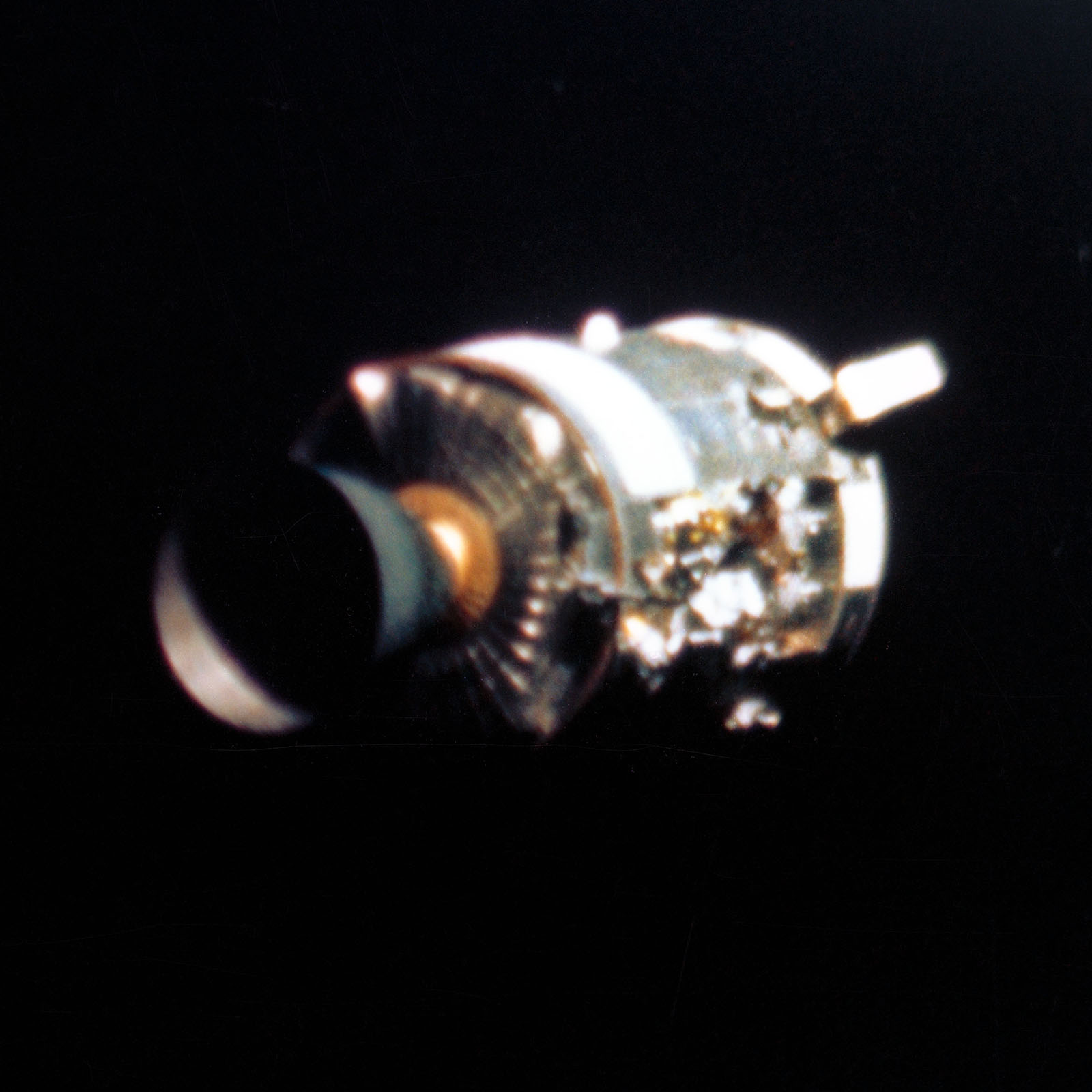
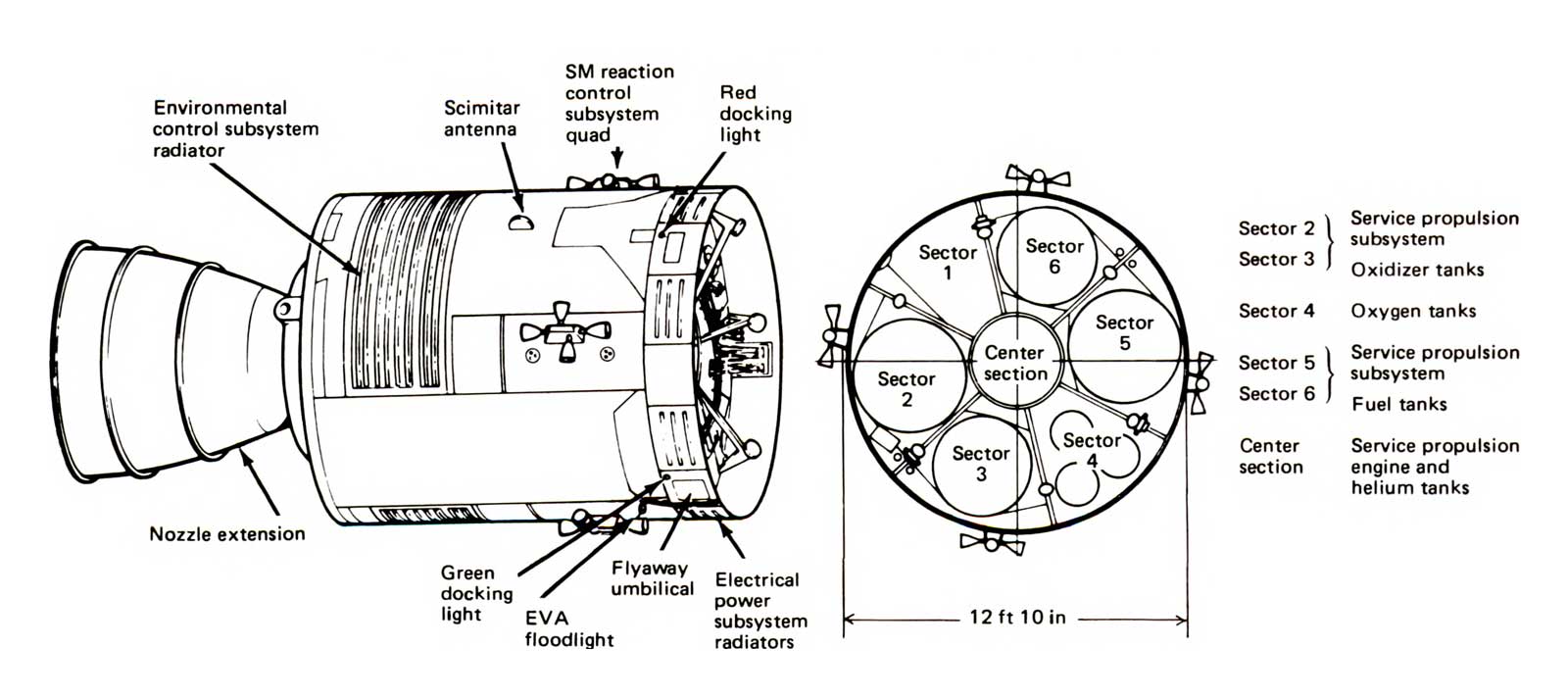
The pressure in the No. 1 oxygen tank continued to drift downward; passing 300 psi, now heading toward 200 psi. Months later, after the accident investigation was complete, it was determined that, when No. 2 tank blew up, it either ruptured a line on the No. 1 tank, or caused one of the valves to leak. When the pressure reached 200 psi, it was obvious that we were going to lose all oxygen, which meant that the last fuel cell would also die. At 1 hour and 29 seconds after the bang, Jack Lousma, then CapCom, said after instructions from Flight Director Glynn Lunney: “It is slowly going to zero, and we are starting to think about the LM lifeboat.” Swigert replied, “That’s what we have been thinking about too.”
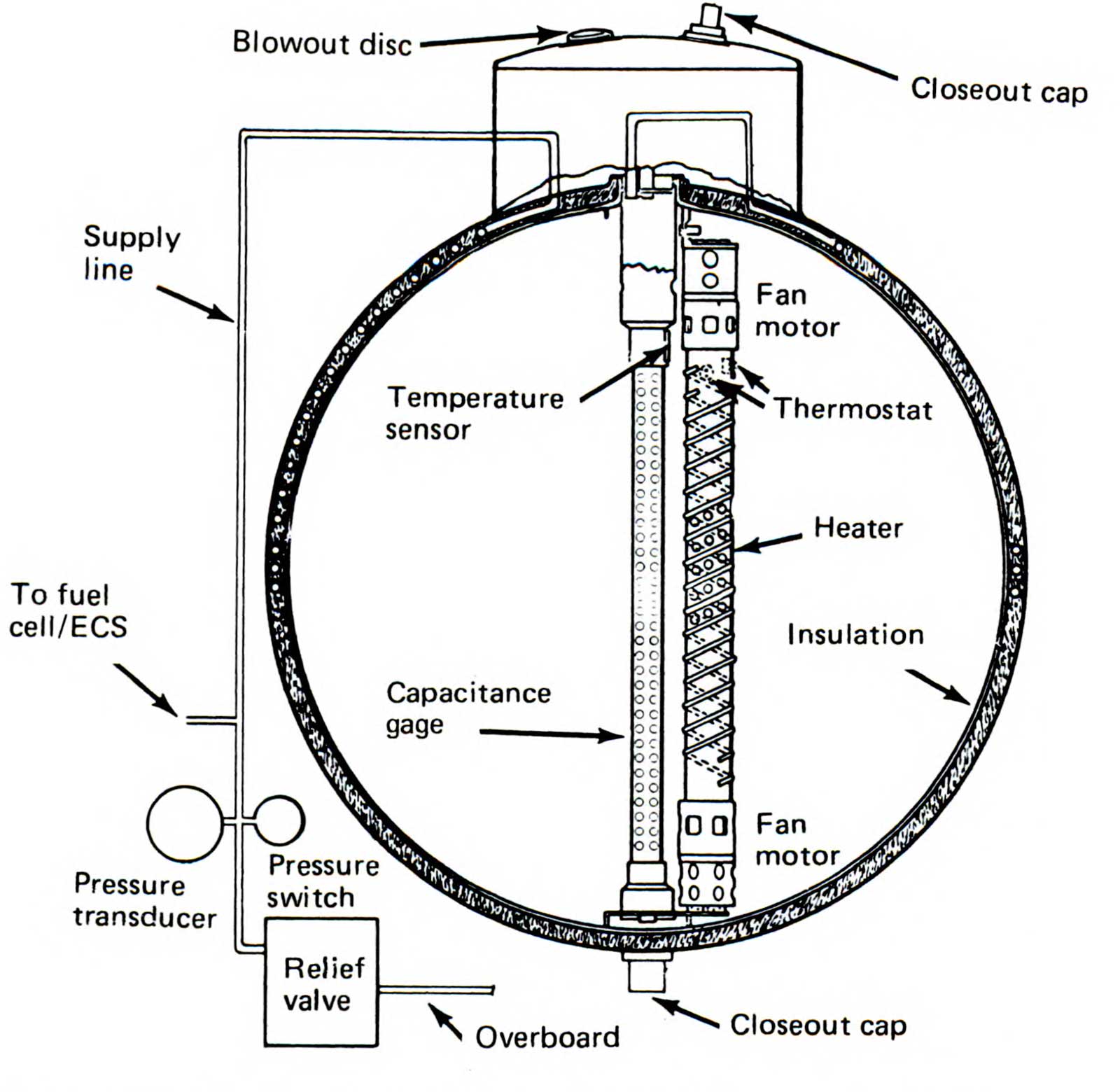
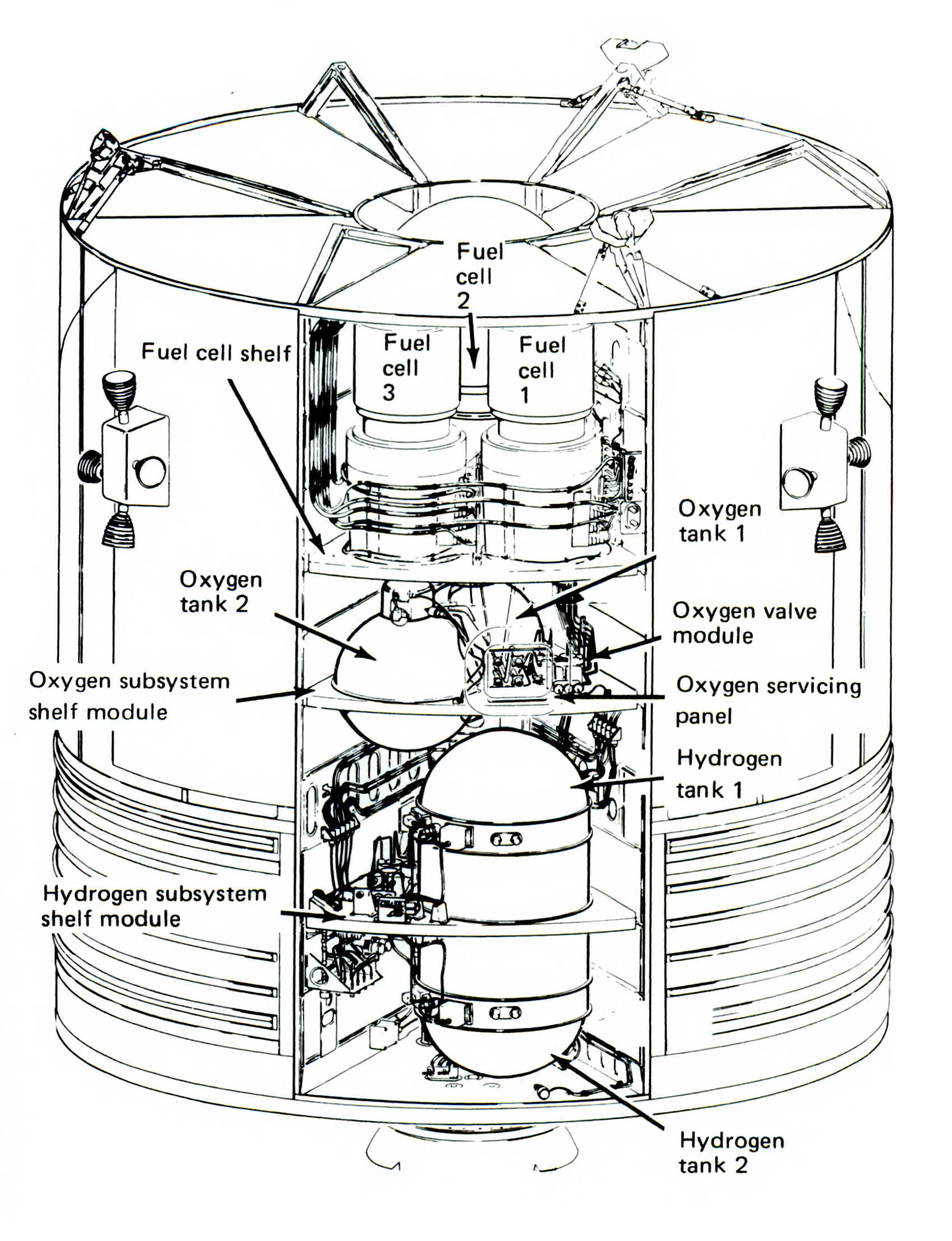
A lot has been written about using the LM as a lifeboat after the CM has become disabled. There are documents to prove that the lifeboat theory was discussed just before the Lunar Orbit Rendezvous mode was chosen in 1962. Other references go back to 1963, but by 1964 a study at the Manned Spacecraft Center concluded: “The LM [as lifeboat] . . . was finally dropped, because no single reasonable CSM failure could be identified that would prohibit use of the SPS.” Naturally, I’m glad that view didn’t prevail, and I’m thankful that by the time of Apollo 10, the first lunar mission carrying the LM, the LM as a lifeboat was again being discussed. Fred Haise, fortunately, held the reputation as the top astronaut expert on the LM- after spending fourteen months at the Grumman plant on Long Island, where the LM was built. Fred says: “I never heard of the LM being used in the sense that we used it. We had procedures, and we had trained to use it as a backup propulsion device, the rationale being that the thing we were really covering was the failure of the command module’s main engine, the SPS engine. In that case, we would have used combinations of the LM descent engine, and in some cases, for some lunar aborts, the ascent engine as well. But we never really thought and planned, and obviously, we didn’t have the procedures to cover a case where the command module would end up fully powered down.”
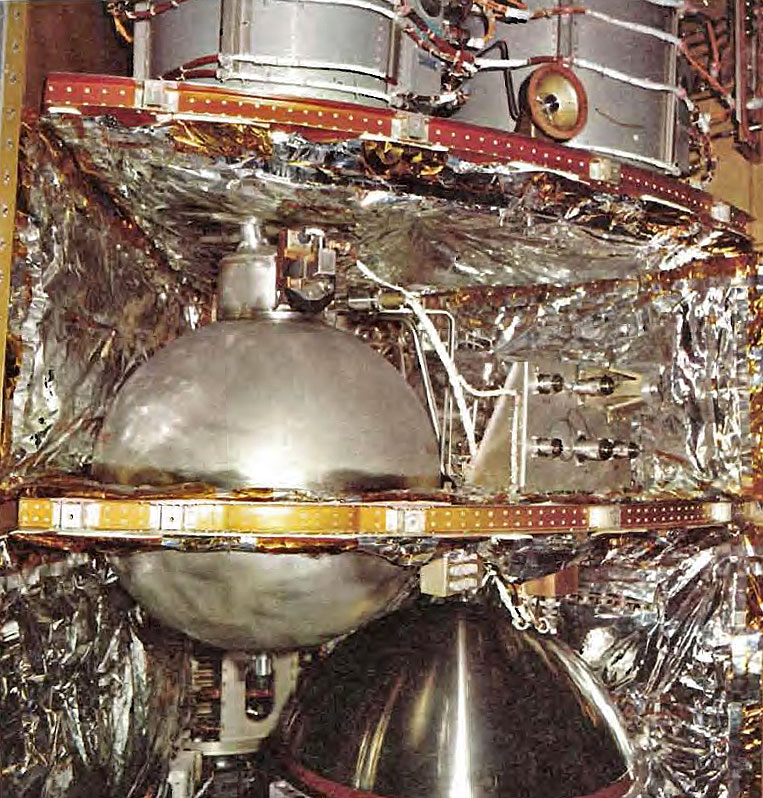
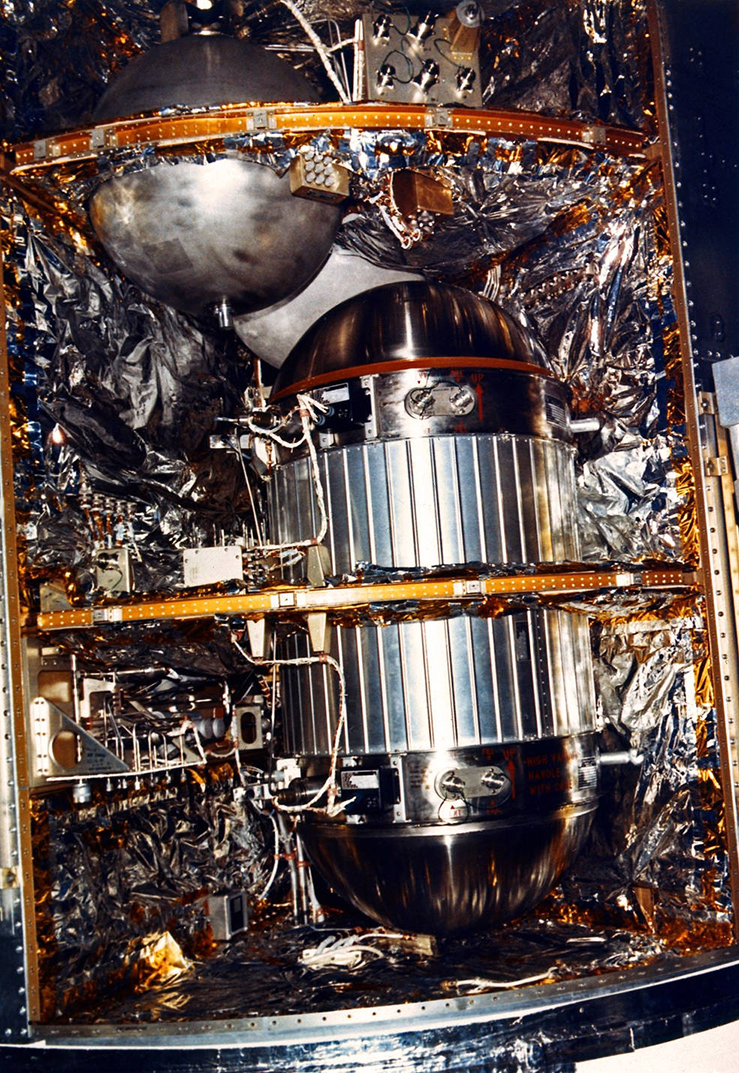
To get Apollo 13 home would require a lot of innovation. Most of the material written about our mission describes the ground-based activities, and I certainly agree that without the splendid people in Mission Control, and their backups, we’d still be up there.
They faced a formidable task. Completely new procedures had to be written and tested in the simulator before being passed up to us. The navigation problem was also theirs; essentially how, when, and in what attitude to burn the LM descent engine to provide a quick return home. They were always aware of our safety, as exemplified by the jury-rig fix of our environmental system to reduce the carbon dioxide level.
However, I would be remiss not to state that it really was the teamwork between the ground and flight crew that resulted in a successful return. I was blessed with two shipmates who were very knowledgeable about their spacecraft systems. and the disabled service module forced me to relearn quickly how to control spacecraft attitude from the LM, a task that became more difficult when we turned off the attitude indicator.
FIFTEEN MINUTES OF POWER LEFT
With only 15 minutes of power left in the CM, CapCom told us to make our way into the LM. Fred and I quickly floated through the tunnel, leaving Jack to perform the last chores in our forlorn and pitiful CM that had seemed such a happy home less than two hours earlier. Fred said something that strikes me as funny as I read it now: “Didn’t think I’d be back so soon.” But nothing seemed funny in real time on that 13th of April, 1970.
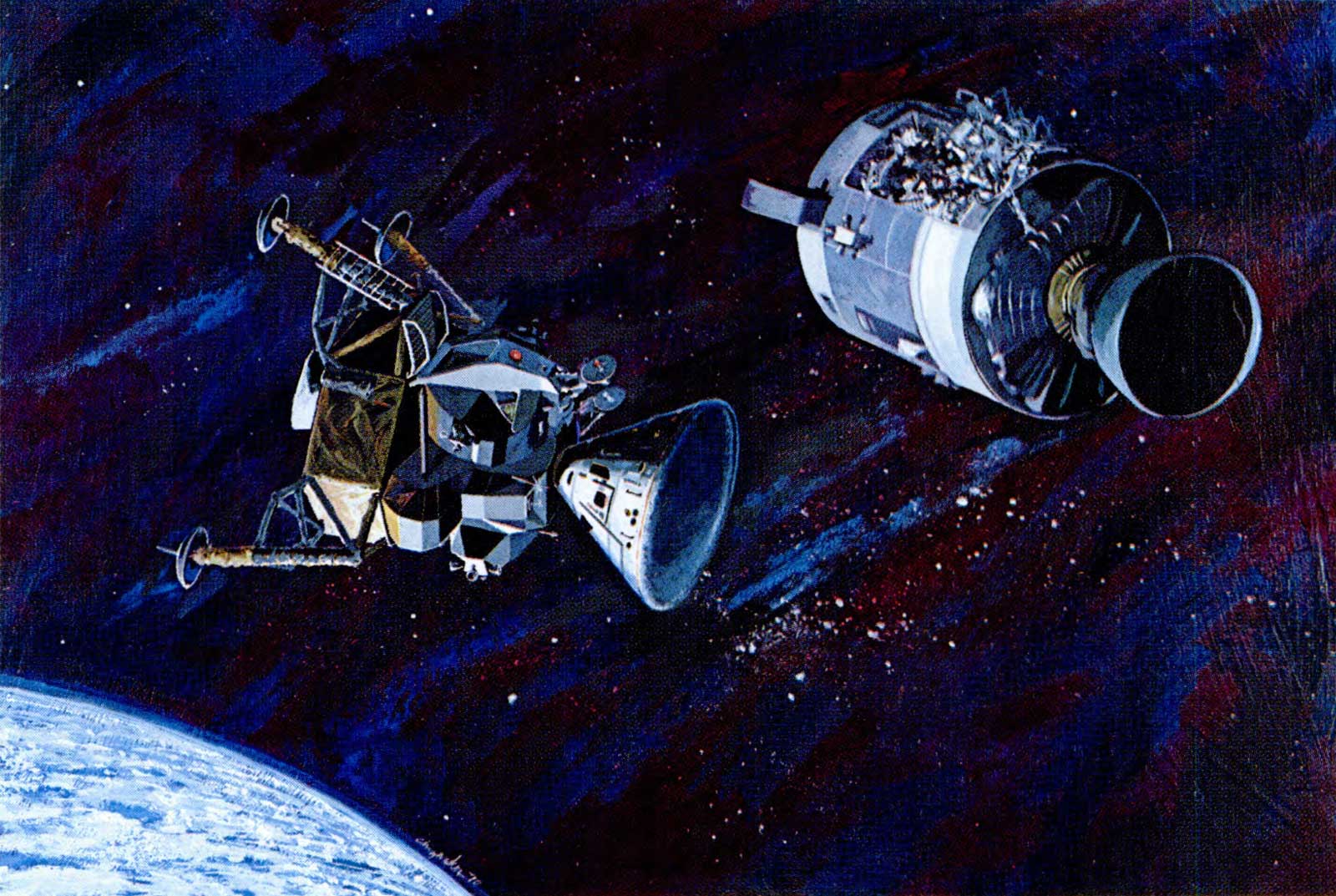
There were many, many things to do. In the first place, did we have enough consumables to get home? Fred started calculating, keeping in mind that the LM was built for only a 45-hour lifetime, and we had to stretch that to 90. He had some data from previous LMs in his book — average rates of water usage related to amperage level, rate of water needed for cooling. It turned out that we had enough oxygen. The full LM descent tank alone would suffice, and in addition, there were two ascent-engine oxygen tanks, and two backpacks whose oxygen supply would never be used on the lunar surface. Two emergency bottles on top of those packs had six or seven pounds each in them. (At LM jettison, just before reentry, 28.5 pounds of oxygen remained, more than half of what we started with.)
We had 2181 ampere hours in the LM batteries. We thought that was enough if we turned off every electrical power device not absolutely necessary. We could not count on the precious CM batteries, because they would be needed for reentry after the LM was cast off. In fact, the ground carefully worked out a procedure where we charged the CM batteries with LM power. As it turned out, we reduced our energy consumption to a fifth of normal, which resulted in our having 20 percent of our LM electrical power left when we jettisoned Aquarius. We did have one electrical heart-stopper during the mission. One of the CM batteries vented with such force that it momentarily dropped off the line. We knew we were finished if we permanently lost that battery.
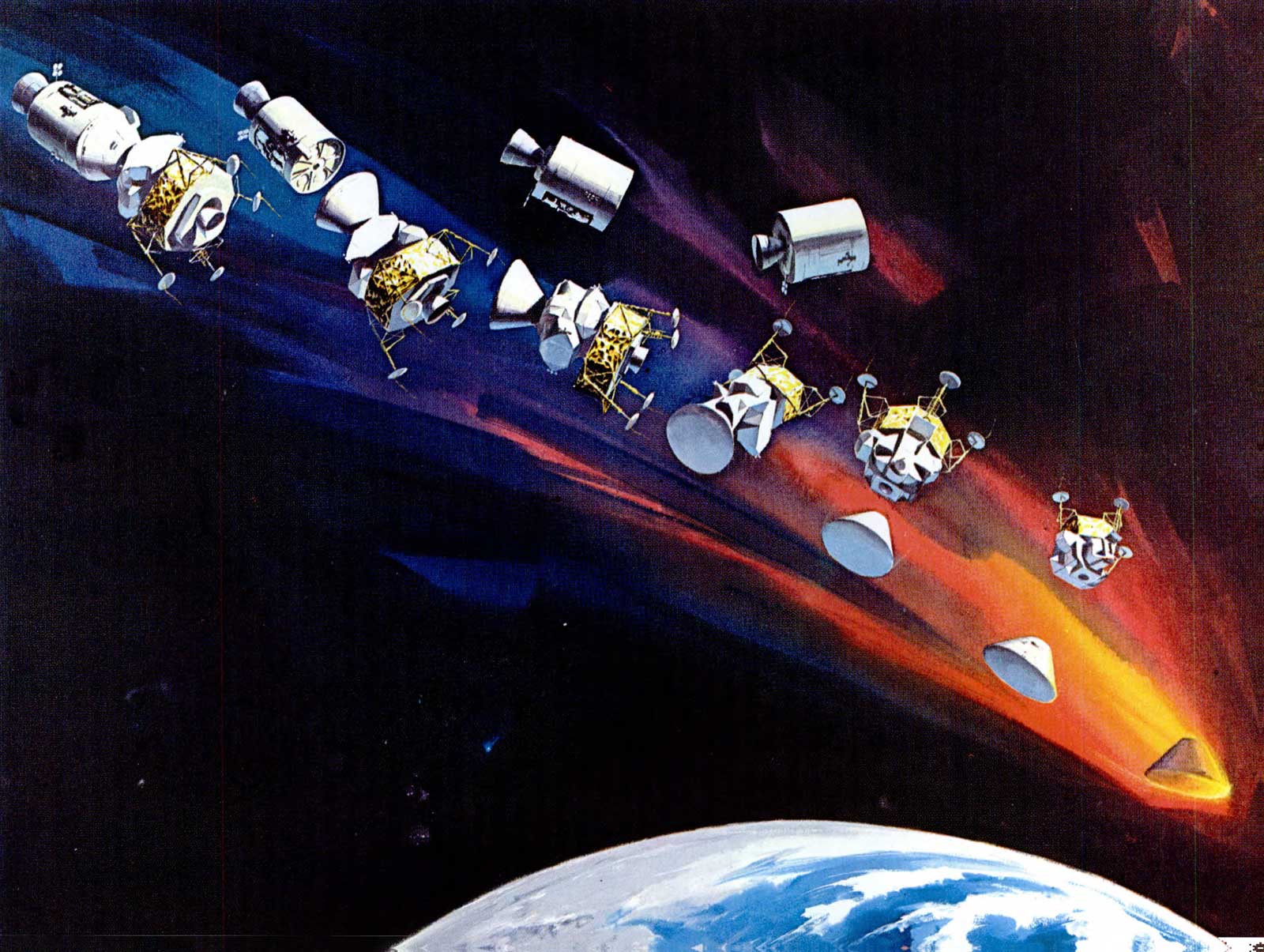
Water was the real problem. Fred figured that we would run out of water about five hours before we got back to Earth, which was calculated at around 151 hours. But even there, Fred had an ace in the hole. He knew we had a data point from Apollo 11, which had not sent its LM ascent stage crashing into the Moon, as subsequent missions did. An engineering test on the vehicle showed that its mechanisms could survive seven or eight hours in space without water cooling, until the guidance system rebelled at this enforced toasting. But we did conserve water. We cut down to six ounces each per day, a fifth of normal intake, and used fruit juices; we ate hot dogs and other wet-pack foods when we ate at all. (We lost hot water with the accident and dehydratable food is not palatable with cold water.) Somehow, one doesn’t get very thirsty in space and we became quite dehydrated. I set one record that stood up throughout Apollo: I lost fourteen pounds, and our crew set another by losing a total of 31.5 pounds, nearly 50 percent more than any other crew. Those stringent measures resulted in our finishing with 28.2 pounds of water, about 9 percent of the total.
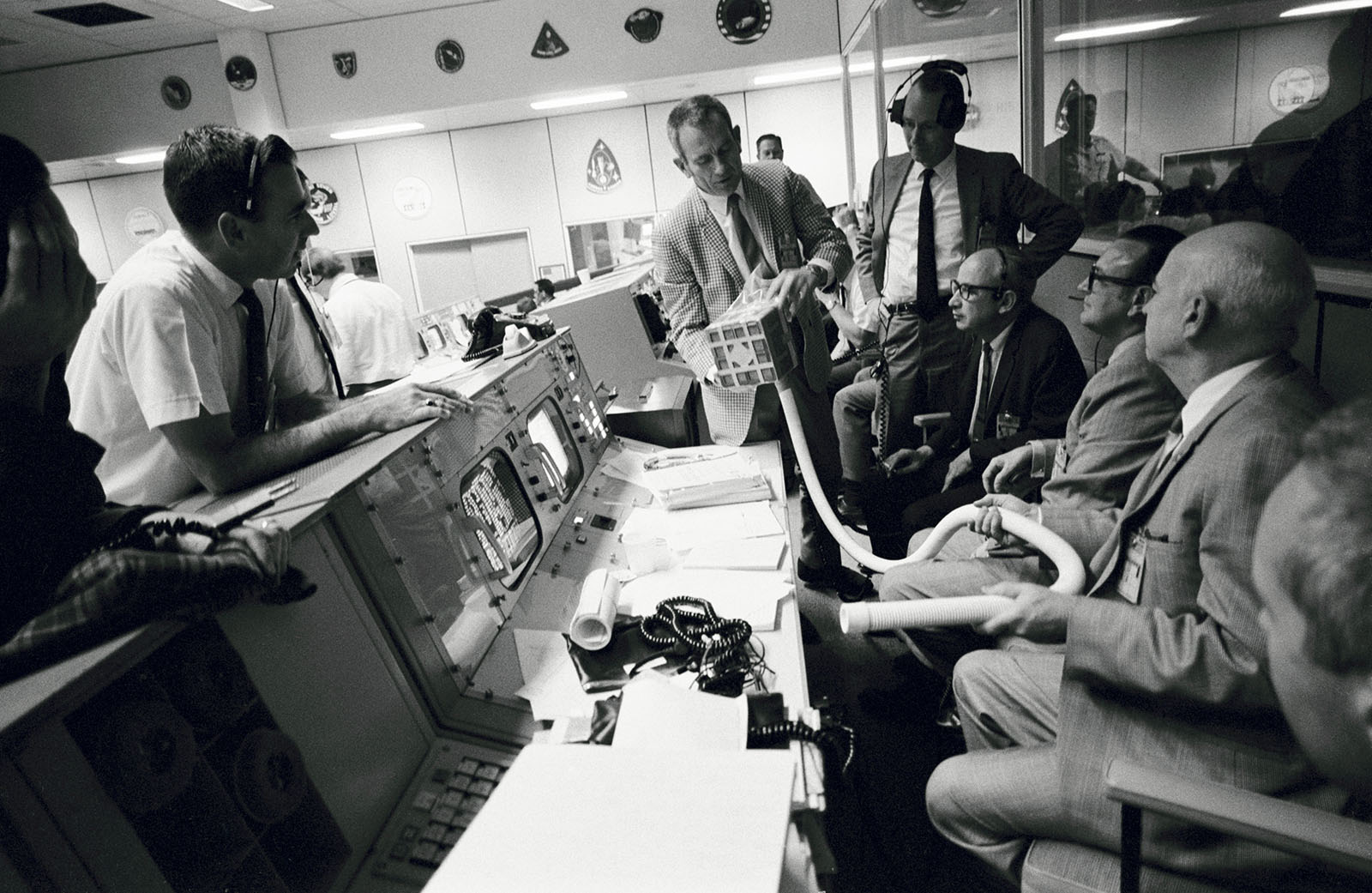
Fred had figured that we had enough lithium hydroxide canisters, which remove carbon dioxide from the spacecraft. There were four cartridge from the LM, and four from the backpacks, counting backups. But he forgot that there would be three of us in the LM instead of the normal two. The LM was designed to support two men for two days. Now it was being asked to care for three men nearly four days.
A SQUARE PEG IN A ROUND HOLE
We would have died of the exhaust from our own lungs if Mission Control hadn’t come up with a marvelous fix. The trouble was the square lithium hydroxide canisters from the CM would not fit the round openings of those in the LM environmental system. After a day and a half in the LM a warning light showed us that the carbon dioxide had built up to a dangerous level, but the ground was ready. They had thought up a way to attach a CM canister to the LM system by using plastic bags, cardboard, and tape- all materials we had on board. Jack and I put it together: just like building a model airplane. The contraption wasn’t very handsome, but it worked. It was a great improvisation- and a fine example of cooperation between ground and space.
The big question was, “How do we get back safely to Earth?” The LM navigation system wasn’t designed to help us in this situation. Before the explosion, at 30 hours and 40 minutes, we had made the normal midcourse correction, which would take us out of a free-return-to-Earth trajectory and put us on our lunar landing course. Now we had to get back on that free-return course. The ground-computed 35-second burn, by an engine designed to land us on the Moon, accomplished that objective 5 hours after the explosion.
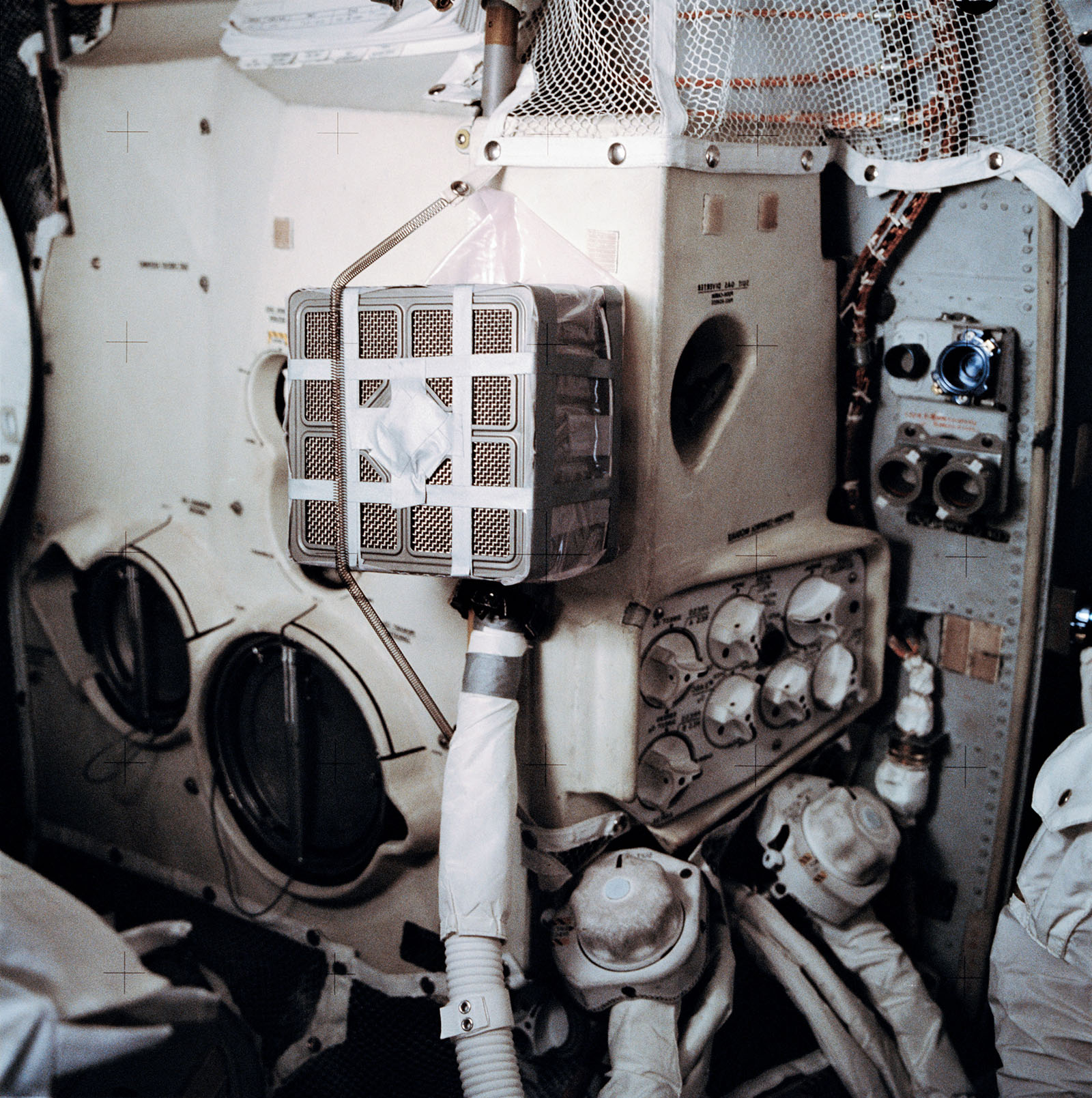
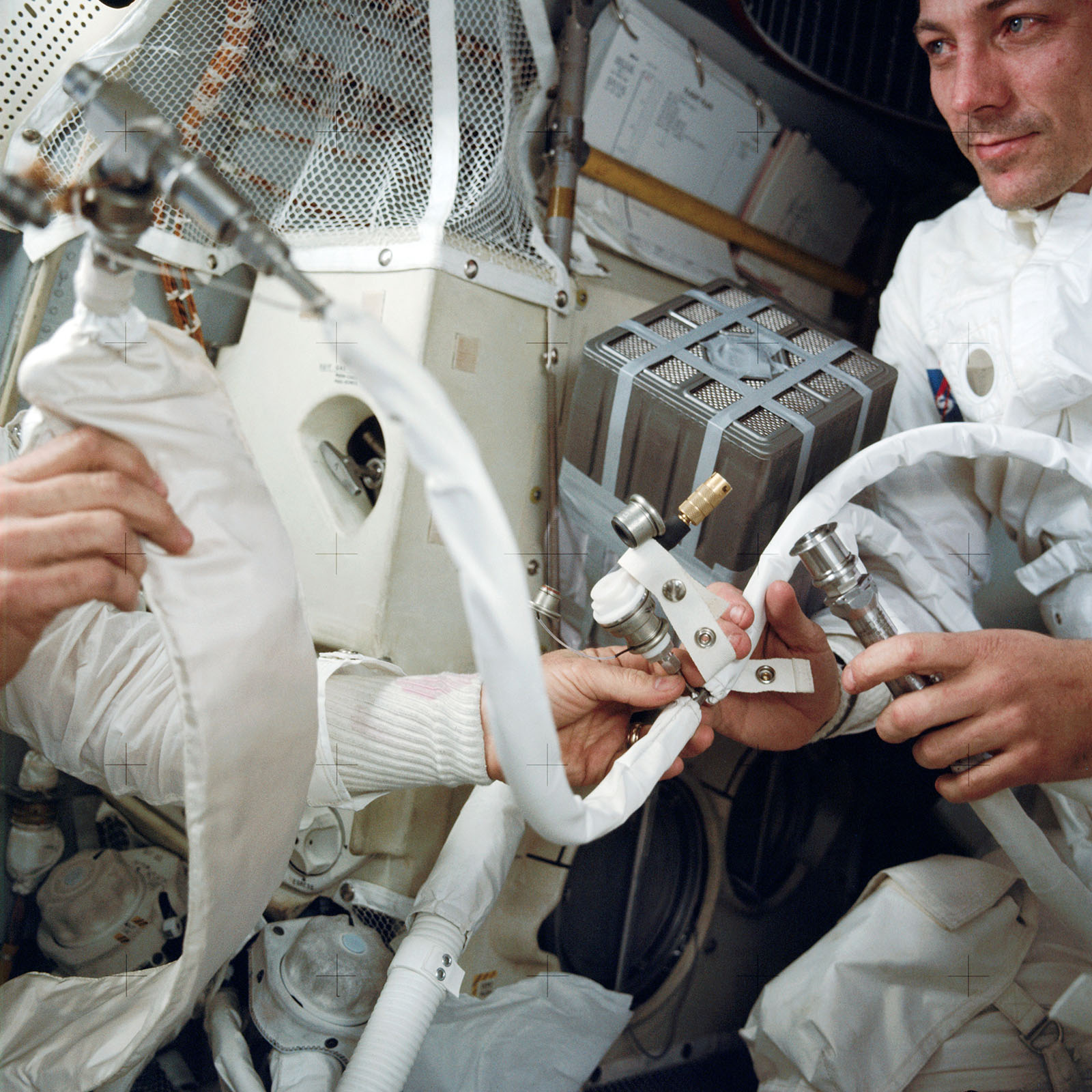
As we approached the Moon, the ground informed us that we would have to use the LM descent engine a second time; this time a long 5-minute burn to speed up our return home. The maneuver was to take place 2 hours after rounding the far side of the Moon, and I was busy running down the procedures we were to use. Suddenly, I noticed that Swigert and Haise had their cameras out and were busy photographing the lunar surface. I looked at them incredulously and said, “If we don’t make this next maneuver correctly, you won’t get your pictures developed!” They said, “Well, you’ve been here before and we haven’t.” Actually, some of the pictures these tourists took turned out to be very useful.
It was about this time that I said, “Boys, take a good look at the Moon. It’s going to be a long time before anybody gets up here again.” Later on I was accused of sabotaging Apollo; poor Dr. Paine had to explain that I didn’t really mean it, and the space program would go on. The Senate Space Committee asked me about it a week after we got back. Actually, I didn’t mean that remark to be public. (I later learned that, unknown to us, we had had a hot mike for about 45 minutes.) Nonetheless, it was 9 months before Apollo 14 was launched.
We had many crises on Apollo 13, but the biggest heart- stopper has hardly been noticed, partly because the transcription released to the press was garbled, and partly because there wasn’t much point in talking about a crisis that had been averted earlier. It occurred prior to the second maneuver I mentioned earlier; we called it P.C. + 2 (pericynthian 2 hours).
We had transferred the CM platform alignment to the LM. but we had to make sure that this alignment was accurate before we made the long P.C. + 2 burn. Ordinarily it is simple to look through the sextant device, called the Alignment Optical Telescope, find a suitable navigation star, and with the help of our computer verify the guidance platform’s alignment. But traveling with us was a swarm of debris from the ruptured service module. The sunlight glinting on these bits of junk- I called them false stars- made it impossible to sight a real star.
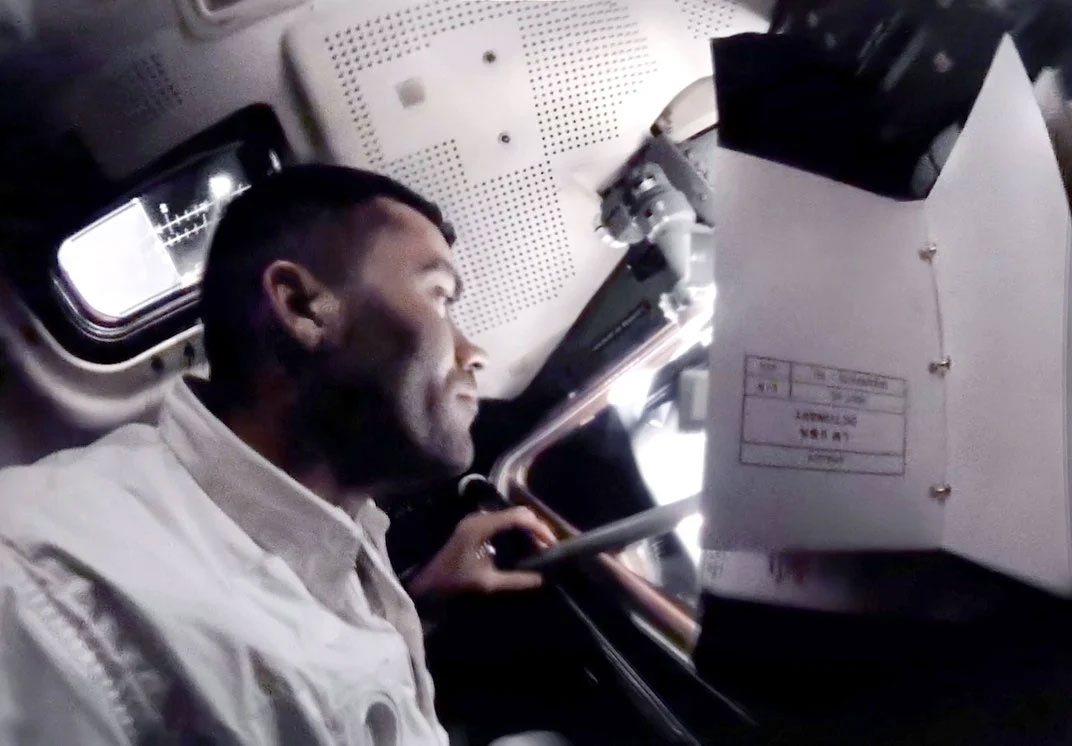
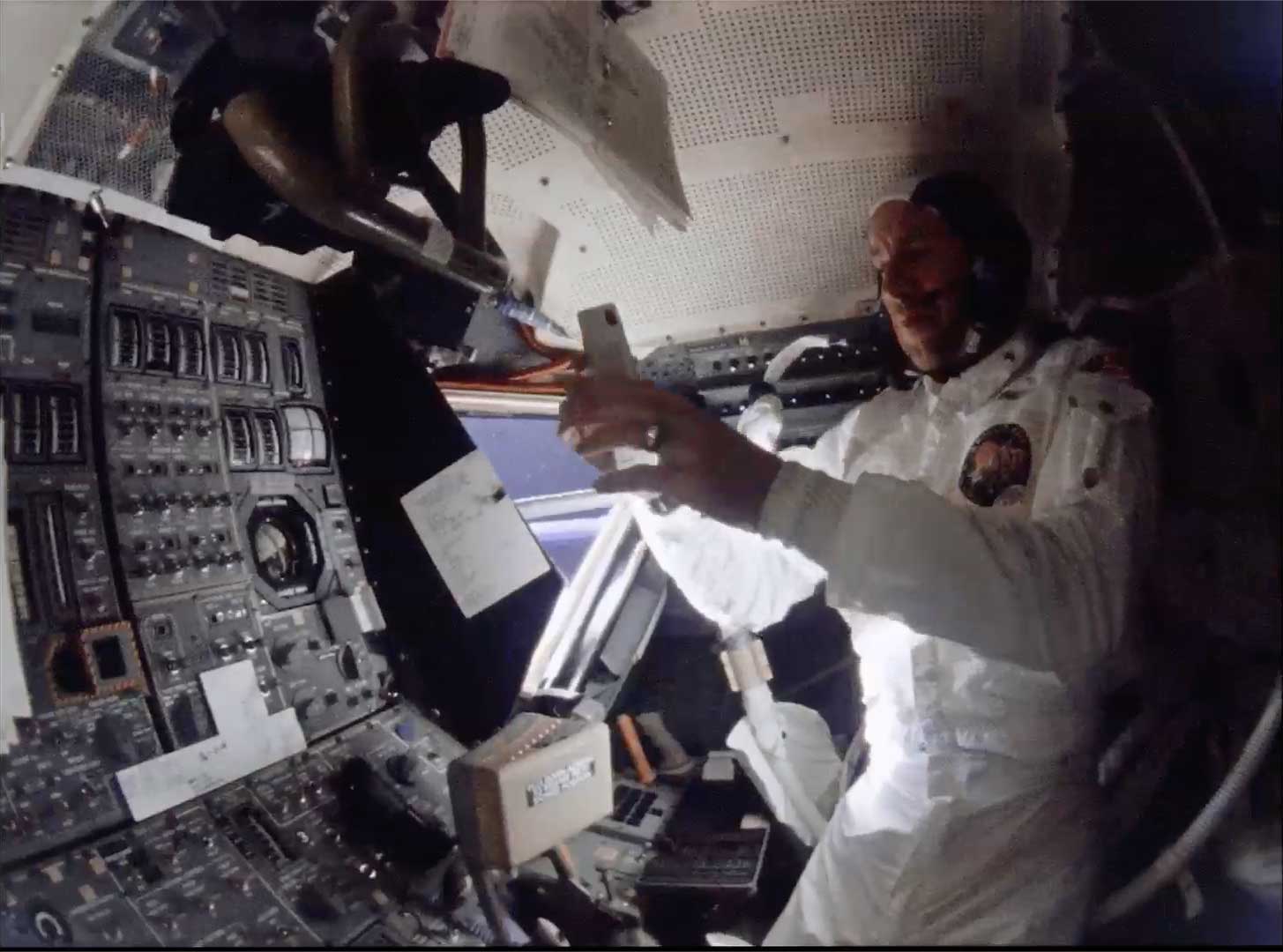
So what to do? If we couldn’t verify the accuracy of the alignment, we didn’t have a way to make an accurate burn, or to align the CM platform for reentry. In other words, the ground would have no accurate way to tell us the correct attitude to make the proper maneuvers to return home.
A genius in Mission Control came up with the idea of using the Sun to check the accuracy of our alignment. No amount of debris could blot out that star! Its large diameter could result in considerable error, but nobody had a better plan.
I rotated the spacecraft to the attitude Houston had requested. If our alignment was accurate, the Sun would be centered in the sextant.
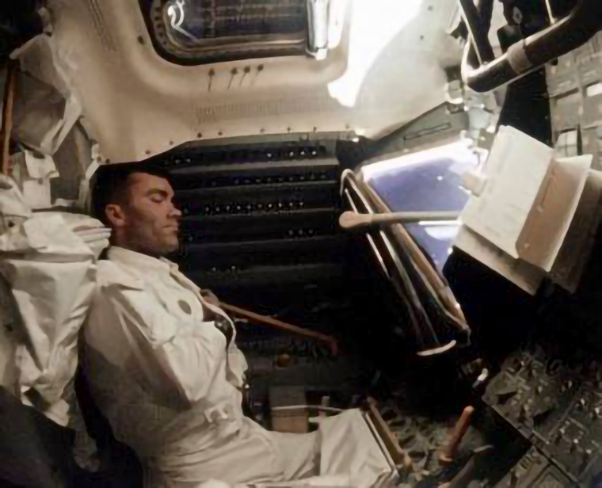
When I looked through the AOT, the Sun just had to be there. It really had to be. And it was. At 73:46 hours the air-to-ground transcript sounds like a song from “My Fair Lady":
Lovell: O.K. We got it. I think we got it. What diameter was it?
Haise: Yes. It’s coming back in. Just a second.
Lovell: Yes, yaw’s coming back in. Just about it.
Haise: Yaw is in....
Lovell: What have you got?
Haise: Upper right corner of the Sun....
Lovell: We’ve got it!
If we raised our voices, I submit it was justified.
I’m told the cheer of the year went up in Mission Control. Flight Director Gerald Griffin, a man not easily shaken, recalls: “Some years later I went back to the log and looked up that mission. My writing was almost illegible I was so damned nervous. And I remember the exhilaration running through me: My God, that’s kinds the last hurdle — if we can do that, I know we can make it. It was funny, because only the people involved knew how important it was to have that platform properly aligned.” Yet Gerry Griffin barely mentioned the alignment in his change-of- shift briefing — “That check turned out real well” is all he said an hour after his penmanship failed him Neither did we, as crew members, refer to it as a crisis in our press conference nor in later articles.
The alignment with the Sun proved to be less than a half a degree off. Hallelujah Now we knew we could do the 5-minute P.C. + 2 burn with assurance, and that would cut the total time of our voyage to about 142 hours. We weren’t exactly home free: we had a dead service module, a command module with no power, and a lunar module that was a wonderful vehicle to travel home in, but unfortunately didn’t have a heat shield required to enter the Earth’s atmosphere. But all we needed now was a continuation of the expertise we seemed blessed with, plus a little luck.
TIRED, HUNGRY, WET, COLD, DEHYDRATED
The trip was marked by discomfort beyond the lack of food and water. Sleep was almost impossible because of the cold. When we turned off the electrical systems, we lost our source of heat, and the Sun streaming in the windows didn’t much help. We were as cold as frogs in a frozen pool, especially Jack Swigert, who got his feet wet and didn’t have lunar overshoes. It wasn’t simply that the temperature dropped to 38 F: the sight of perspiring walls and wet windows made it seem even colder. We considered putting on our spacesuits, but they would have been bulky and too sweaty. Our teflon-coated inflight coveralls were cold to the touch, and how we longed for some good old thermal underwear.
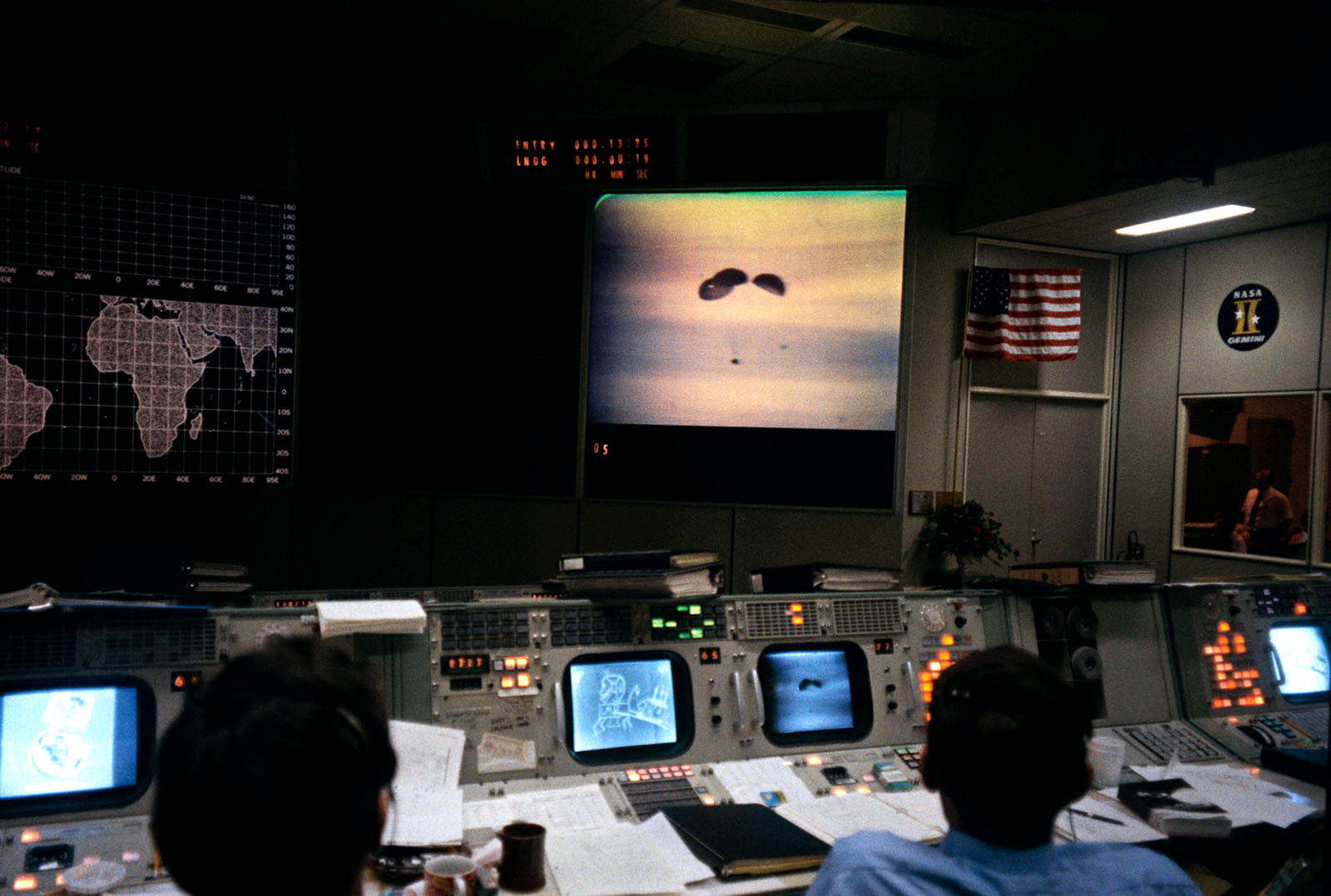
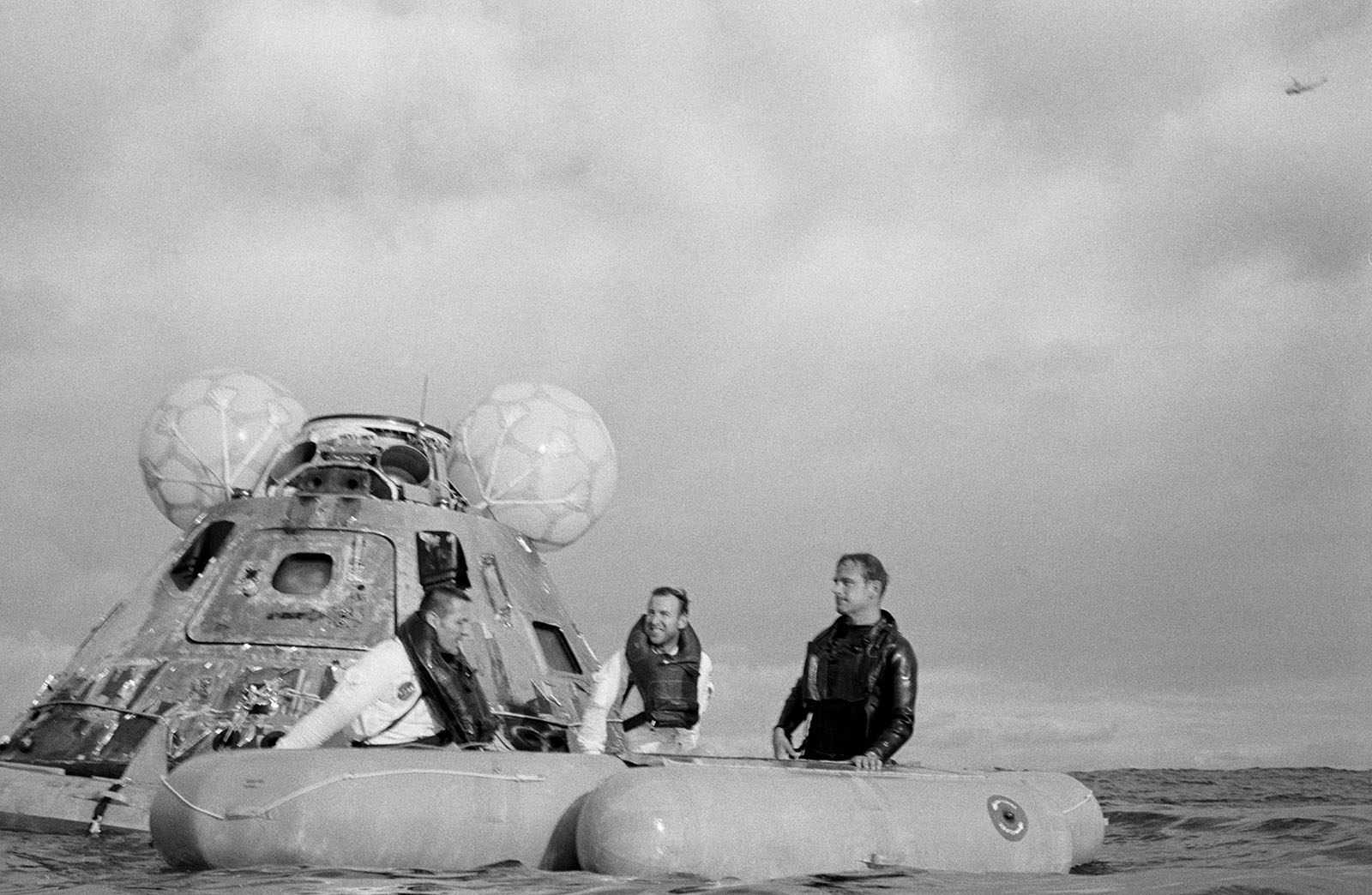
The ground, anxious not to disturb our homeward trajectory, told us not to dump any waste material overboard. What to do with urine taxed our ingenuity. There were three bags in the command module; we found six little ones in the LM, then we connected a PLSS condensate tank to a long hoses and finally we used two large bags designed to drain remaining water out of the PLSS’s after the first lunar EVA. I’m glad we got home when we did, because we were just about out of ideas for stowage.
A most remarkable achievement of Mission Control was quickly developing procedures for powering up the CM after its long cold sleep. They wrote the documents for this innovation in three days, instead of the usual three months. We found the CM a cold, clammy tin can when we started to power up. The walls, ceiling, floor, wire harnesses, and panels were all covered with droplets of water. We suspected conditions were the same behind the panels. The chances of short circuits caused us apprehension, to say the least. But thanks to the safeguards built into the command module after the disastrous fire in January 1967, no arcing took place. The droplets furnished one sensation as we decelerated in the atmosphere: it rained inside the CM.
Four hours before landing, we shed the service module; Mission Control had insisted on retaining it until then because everyone feared what the cold of space might do to the unsheltered CM heat shield. I’m glad we weren’t able to see the SM earlier. With one whole panel missing, and wreckage hanging out, it was a sorry mess as it drifted away.
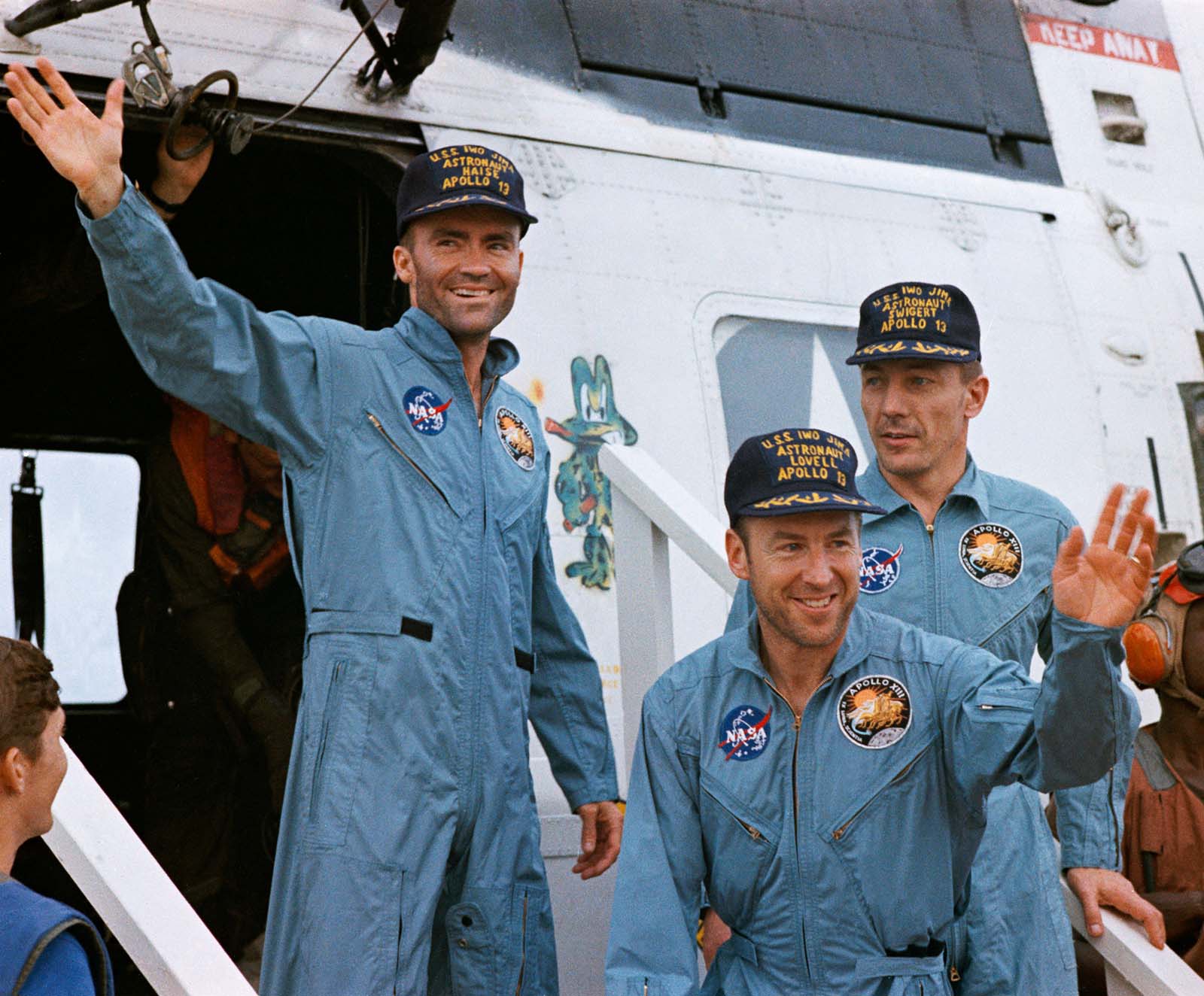
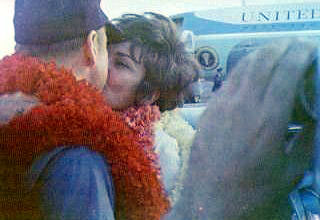
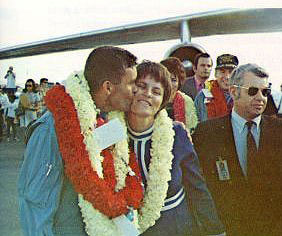
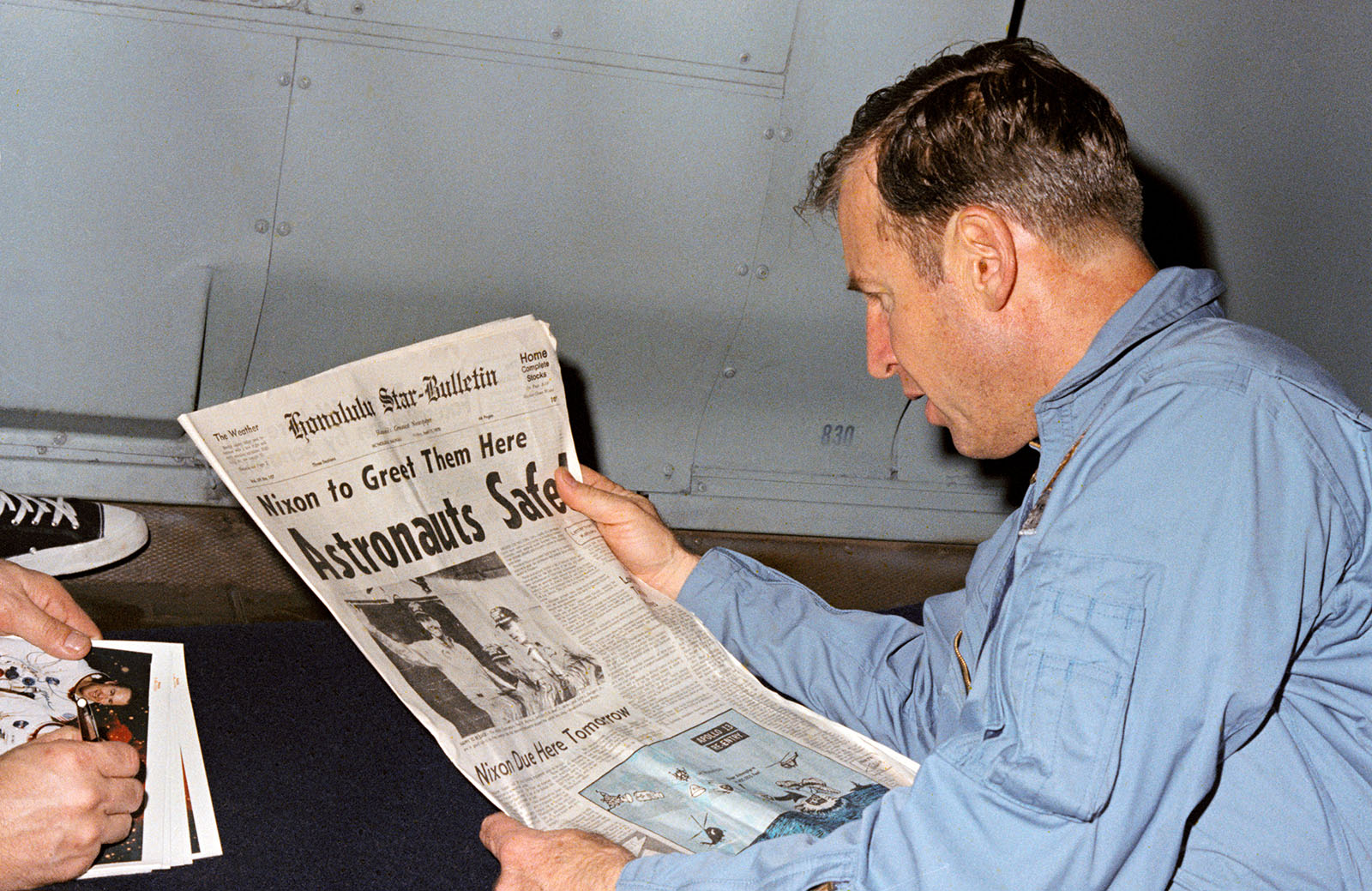
Three hours later we parted with faithful Aquarius, rather rudely, because we blasted it loose with pressure in the tunnel in order to make sure it completely cleared. Then we splashed down gently in the Pacific Ocean near Samoa, a beautiful landing in a blue-ink ocean on a lovely, lovely planet.
Nobody believes me, but during this six-day odyssey we had no idea what an impression Apollo 13 made on the people of Earth. We never dreamed a billion people were following us on television and radio, and reading about us in banner headlines of every newspaper published. We still missed the point on board the carrier Iwo Jima, which picked us up, because the sailors had been as remote from the media as we were. Only when we reached Honolulu did we comprehend our impact: there we found President Nixon and Dr. Paine to meet us, along with my wife Marilyn, Fred’s wife Mary (who being pregnant, also had a doctor along just in case), and bachelor Jack’s parents, in lieu of his usual airline stewardesses.
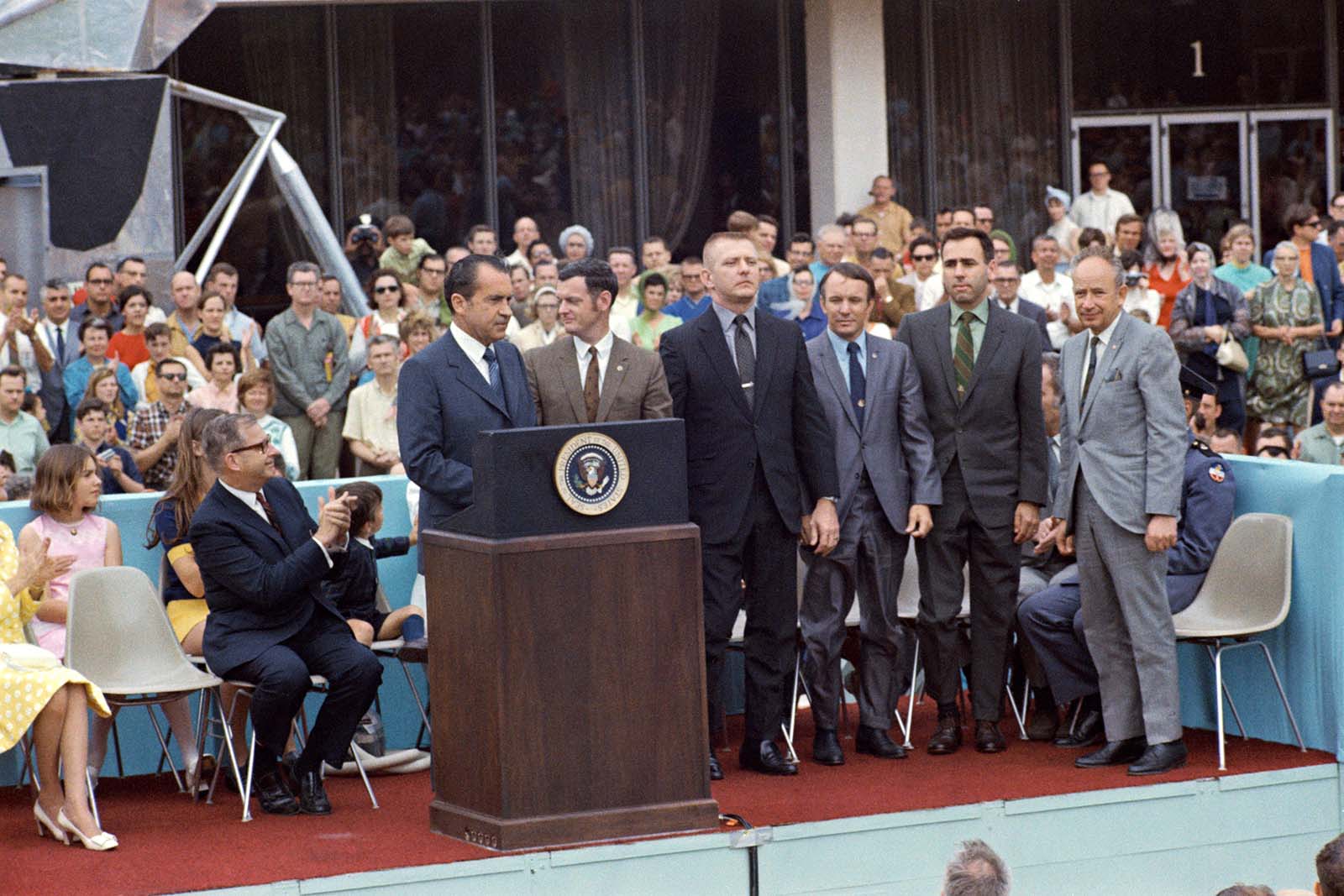
In case you are wondering about the cause of it all, I refer you to the report of the Apollo 13 Review Board, issued after an intensive investigation. In 1965 the CM had undergone many improvements, which included raising the permissible voltage to the heaters in the oxygen tanks from 28 to 65 volts DC. Unfortunately, the thermostatic switches on these heaters weren’t modified to suit the change. During one final test on the launch pad, the heaters were on for a long period of time. “This subjected the wiring in the vicinity of the heaters to very high temperatures (1000 F), which have been subsequently shown to severely degrade teflon insulation . . . the thermostatic switches started to open while powered by 65 volts DC and were probably welded shut.” Furthermore, other warning signs during testing went unheeded and the tank, damaged from 8 hours overheating, was a potential bomb the next time it was filled with oxygen. That bomb exploded on April 13, 1970 - 200,000 miles from Earth.
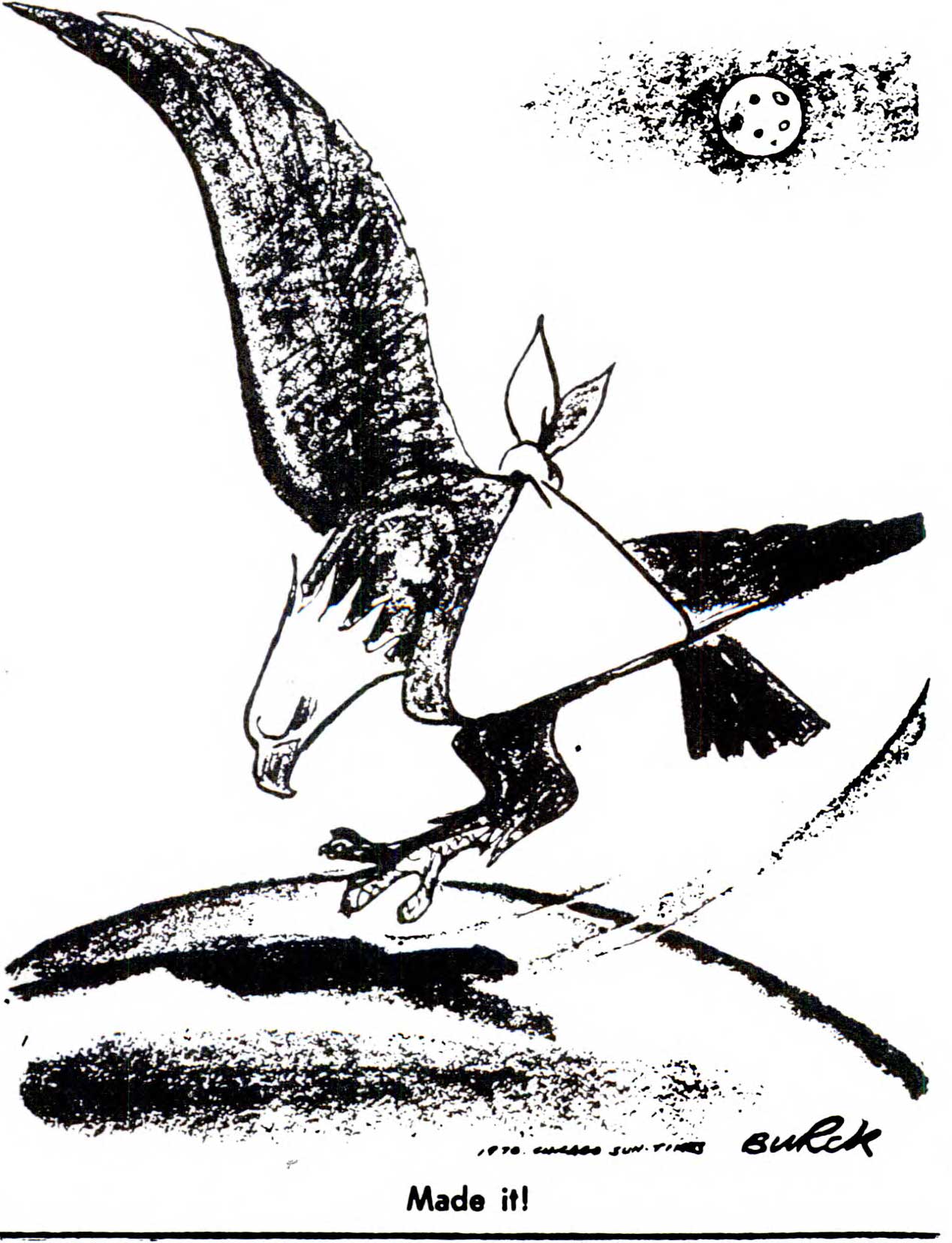
Detailed Chronology From 2.5 Minutes Before The Accident To About 5 Minutes After
| GET * | |
|---|---|
| 55:52:31 | Master caution and warning triggered by low hydrogen pressure in tank No. 1. |
| 55:52:58 | CapCom (Jack Lousma): “13, we’ve got one more item for you, when you get a chance. We’d like you to stir up your cryo tanks. In addition, I have shaft and trunnion-" |
| 55:53:06 | Swigert- “Okay." |
| 55:53:07 | ”-for looking at the Comet Bennett, if you need it." |
| 55:53:12 | Swigert- “Okay. Stand by." |
| 55:53:18 | Oxygen tank No. 1 fans on. |
| 55:53:19 | Oxygen tank No. 2 pressure decreases 8 psi. |
| 55:53:20 | Oxygen tank No. 2 fans turned on. |
| 55:53:20 | Stabilization control system electrical disturbance indicates a power transient. |
| 55:53:21 | Oxygen tank No. 2 pressure decreases 4 psi. |
| 55:53:22.718 | Stabilization control system electrical disturbance indicates a power transient. |
| 55:53:22.757 | 1.2-volt decrease in cic bus 2 voltage. |
| 55:53:22.772 | 11.1-amp rise in fuel cell 3 current for one sample. |
| 55:53:36 | Oxygen tank No. 2 pressure begins rise lasting for 24 seconds. |
| 55:53:38.057 | 11-volt decrease in ac bus 2 voltage for one sample. |
| 55:53:38.085 | Stabilization control system electrical disturbance indicates a power transient. |
| 55:53:41.172 | 22.9-amp rise in fuel cell 3 current for one sample. |
| 55:53:41.192 | Stabilization control system electrical disturbance indicates a power transient. |
| 55:54:00 | Oxygen tank No. 2 pressure rise ends of a pressure of 953.8 psia. |
| 55:54:15 | Oxygen tank No. 2 pressure begins to rise. |
| 55:54:30 | Oxygen tank No. 2 quantity drops from full scale for 2 seconds and then reads 75.3 percent. |
| 55:54:31 | Oxygen tank No. 2 temperature begins to rise rapidly. |
| 55:54:43 | Flow rate of oxygen to all three fuel cells begins to decrease. |
| 55:54:45 | Oxygen tank No. 2 pressure reaches maximum volue of 1008.3 psia. |
| 55:54:51 | Oxygen tank No. 2 quantity jumps to off-scale high and then begins to drop until the time of telemetry loss, indicating from 2.5 minutes be re failed sensor. |
| 55:54:52 | Oxygen tank No. 2 temperature reads -151.30° F. |
| 55:54:52.703 | Oxygen tank No. 2 temperature suddenly goes off-scale low, indicating failed sensor. |
| 55:54:52.763 | Last telemetered pressure from oxygen tank No. 2 before telemetry loss is 995.7 psia. |
| 55:54:53.182 | Sudden accelerometer activity on X, Y, Z axes. |
| 55:54:53.220 | Stabilization control system rate changes begin. |
| 55:54:53.323 | Oxygen tank No. 1 pressure drops 4.2 psi. |
| 55:54:53.500 | 2.8-amp rise in total fuel cell current. |
| 55:54:53.542 | X, Y, and Z accelerations in CM indicate 1.179, 0.65g, and 0.659. |
| 55:54:53.555 | Loss of telemetry. |
| 55:54:53.555+ | Master caution and warning triggered by dc main bus B undervoltage. Alarm is turned off in 6 seconds. All indications are that the cryogenic oxygen tank No. 2 lost pressure in this time period and the panel separated. |
| 55:54:54.741 | Nitrogen pressure in fuel cell 1 is off-scale low indicating failed sensor. |
| 55:54:55.350 | Telemetry recovered. |
| 55:54:56 | Service propulsion system engine valve body temperature begins a rise of 1.65° F in 7 seconds. Dc main bus A decreases 0.9 volt to 28.5 volts und dc main bus B decreases 0.9 volt to 29.0 volts. Total fuel cell current is 15 amps higher than the final value before telemetry loss. High current continues for 19 seconds. Oxygen tank No. 2 temperature reads offscale high after telemetry recovery, probably indicating failed sensors. Oxygen tank No. 2 pressure reads offscale low following telemetry recovery, indicating a broken supply line, a tank pressure below 19 psi, or a failed sensor. Oxygen tank No. 1 pressure reads 781.9 psia und begins to drop. |
| 55:54:57 | Oxygen tank No. 2 quantity reads off-scale high following telemetry recovery incdicating failed sensor. |
| 55:55:01 | Oxygen flow rates to fuel cells 1 und 3 approached zero after decreasing for 7 seconds. |
| 55:55:02 | The surface temperature of the service module oxidizer tank in bay 3 begins a 3.8° F increase in a 15-second period. The service propulsion system helium tank temperature begins a 3.8° F increase in a 32-second period. |
| 55:55:09 | Dc main bus A voltage recovers to minutes after 29.0 volts; dc main bus B recovers to 28.8. |
| 55:55:20 | Swigert: “Okay, Houston, we’ve had a problem here." |
| 55:55:28 | Lousma: “This is Houston. Say again, please." |
| 55:55:35 | Lovell: “Houston, we’ve had a problem. We’ve had a main B bus undervolt. |
| 55:55:42 | Lousma: “Roger. Main B undervolt." |
| 55:55:49 | Oxygen tank No. 2 temperature begins steady drop lasting 59 seconds, indicating failed sensor. |
| 55:56:10 | Haise: “Okay. Right now, Houston, the voltage is - is looking good. And we had a pretty large bang associated with the caution und warning there. And as I recall, main B was the one that had an amp spike on it once before." |
| 55:56:30 | Lousma: “Roger, Fred." |
| 55:56:38 | Oxygen tank No. 2 quantity becomes erratic for 69 seconds before assuming an off-scale-low state, indicating failed sensor. |
| 55:56:54 | Haise: “In the interim here, we’re starting to go ahead and button up the tunnel again." |
| 55:57:04 | Haise: “That jolt must have rocked the sensor on - see now - oxygen quantity 2. It was oscillating down around 20 to 60 percent. Now it’s full-scale high." |
| 55:57:39 | Master caution and warning triggered by dc main bus B undervoltage alarm is turned off in 6 seconds. |
| 55:57:40 | Dc main bus B drops below 2 25 volts and continues to fall rapidly. |
| 55:57:44 | Lovell: “Okay. And we’re looking at our service module RCS helium 1. We have - B is barber poled and D is barber poled, helium 2, D is barber pole, and secondary propellants, I have A and C barber pole.” Ac bus fails within 2 seconds. |
| 55:57:45 | Fuel cell 3 fails. |
| 55:57:59 | Fuel cell current begins to decrease. |
| 55:58:02 | Master caution and warning caused by ac bus 2 being reset. |
| 55:58:06 | Master caution and warning triggered by dc main bus A undervoltage. |
| 55:58:07 | Dc main bus A drops below 26 25 volts and in the next few seconds levels oft at 25.5 volts. |
| 55:58:07 | Haise: “Ac 2 is showing zip." |
| 55:58:25 | Haise: “Yes, we got a main bus A undervolt now, too, showing. Its reading about 25½. Main B is reading zip right now." |
| 56:00:06 | Master caution and warning triggered by high hydrogen flow rate to fuel cell 2. |
* GET: Ground Elapsed Time (hours, minutes, seconds)